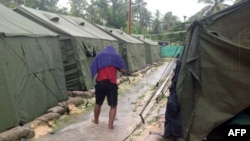Australian officials said one asylum seeker was killed and at least 77 wounded during the second riot this week at a detention center in Papua New Guinea.
The case highlights what some activists claim are unsafe conditions at the remote camp on Manus Island, where asylum seekers trying to reach Australia are sent for processing.
Australian Immigration Minister Scott Morrison said the unrest began after the would-be refugees were told they would have to be resettled in impoverished Papua New Guinea.
He called the incident a "great tragedy," but blamed the asylum seekers for allegedly trying to escape the facility.
"If people choose to remove themselves from that center then they're obviously putting themselves at a place of much greater risk, and in an environment like that where there is violent behavior on the part of those who are breaching the perimeter fence and going out of the center, then this is a disorderly environment, in which there is always great risk," said Morrison.
Some rights groups disagree with that narrative. The Refugee Action Committee said local villagers armed with machetes, pipes, sticks and stones stormed the facility and attacked the asylum seekers.
British security contractor G4S, which guards the facility, denied those accusations, and maintained that the asylum seekers did not leave the facility because of attacks by locals.
Thirty-five asylum seekers broke out of the facility last week. Many have since been re-detained.
Under a policy aimed at deterring asylum seekers, Australia's conservative government has been sending those trying to reach the country by boat to remote camps on either Manus Island or the tiny Pacific island of Nauru.
The United Nations and rights groups have called the camps harsh and say long-term detention at such facilities is inhumane.
Australia claims the policy is necessary to stop people from paying people smugglers to make the unsafe journey, often in rickety boats that crash.
The case highlights what some activists claim are unsafe conditions at the remote camp on Manus Island, where asylum seekers trying to reach Australia are sent for processing.
Australian Immigration Minister Scott Morrison said the unrest began after the would-be refugees were told they would have to be resettled in impoverished Papua New Guinea.
He called the incident a "great tragedy," but blamed the asylum seekers for allegedly trying to escape the facility.
"If people choose to remove themselves from that center then they're obviously putting themselves at a place of much greater risk, and in an environment like that where there is violent behavior on the part of those who are breaching the perimeter fence and going out of the center, then this is a disorderly environment, in which there is always great risk," said Morrison.
Some rights groups disagree with that narrative. The Refugee Action Committee said local villagers armed with machetes, pipes, sticks and stones stormed the facility and attacked the asylum seekers.
British security contractor G4S, which guards the facility, denied those accusations, and maintained that the asylum seekers did not leave the facility because of attacks by locals.
Thirty-five asylum seekers broke out of the facility last week. Many have since been re-detained.
Under a policy aimed at deterring asylum seekers, Australia's conservative government has been sending those trying to reach the country by boat to remote camps on either Manus Island or the tiny Pacific island of Nauru.
The United Nations and rights groups have called the camps harsh and say long-term detention at such facilities is inhumane.
Australia claims the policy is necessary to stop people from paying people smugglers to make the unsafe journey, often in rickety boats that crash.







